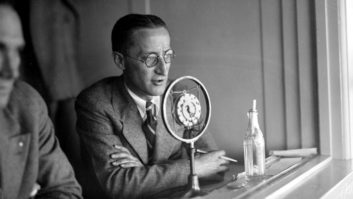
A two-element crossed dipole antenna was mounted on the decorative ball that capped the landmark Detroit building. W8XWJ operated with 100 watts on 31,600 kHz. As early as 1932, the public was becoming dissatisfied with the sound quality of AM broadcasting. They complained about low fidelity, heterodynes and squeals, AC hum on some stations and the ever-present static. The Federal Radio Commission (soon to become the FCC) started investigating the possibility of “high-fidelity” radio.
Their first step was to expand the upper end of the AM band in 1932, setting aside three frequencies for experimental wideband “high-fidelity” stations – 1530, 1550 and 1570 kHz. (One such station, W2XR in New York City, evolved into today’s WQXR-FM.) Their second move was to permit experimental high-fidelity broadcasting on the upper short wave frequencies.
FCC Assistant Chief Engineer Andrew D. Ring called them “Apex” stations. He said “these ultra high frequency stations must be located upon a high point, since their signals simulate light and must ‘rain down’ for good reception.” Because they weren’t limited to the AM band’s 10 kHz channel bandwidth, the new Apex stations could transmit wideband high-fidelity AM.
Dozens of existing AM broadcasters quickly applied for Apex licenses so they could simulcast their programs in high-fidelity and stake out their claim for this new broadcast band. The first Apex station was W8XH in Buffalo, started by WBEN in 1934, and by the end of 1938 there were more than 50 Apex stations. Among these was W8XWJ operated by the Detroit News station WWJ, seen in these photos.
W8XWJ began broadcasting on Jan. 29, 1936, on a frequency of 31,600 kHz. The studio and antenna were on the top floor of the Penobscot Building, one of Detroit’s tallest buildings. A two-element turnstile crossed dipole antenna was mounted on the decorative ball atop the building’s peaked roof. W8XWJ mostly simulcast the regular WWJ programs.
In the photo at left, WWJ Chief Engineer C.H. Wesser is seated at the station’s speech input panel. The RCA 100-F ultra-shortwave transmitter is at left. Also visible is an RCA transcription turntable and an RCA 50A inductor microphone. The transmitters specified an operating range of 30-41 MHz at 100 watts, with an audio frequency response of 30 to 14,000 Hz. Western Electric also produced Apex transmitters for a few years.
The Apex stations suffered the same “chicken and egg” problem that broadcasters have since seen many times with new technologies – a lack of commercially available receivers. The tuning range of most all-band radios in the mid-1930s stopped at about 20 MHz, and only a handful of models tuned the “ultra high frequencies.” Some stations offered converter boxes to the public that would shift the tuning range of standard shortwave radios up to the Apex frequencies.

WWJ Chief Engineer C.H. Wesser works the gear. Another problem was skywave interference between Apex stations. The FCC’s solution was to create 75 channels from 41.02 to 43.98 MHz, separated by 40 kHz. The stations used amplitude modulation, but a few asked for permission to transmit with the experimental and still unproven Frequency Modulation (FM) method. Major Edwin Armstrong, the inventor of FM, was among the first to receive authority to transmit FM from his station W2XMN. The FCC sent its engineers to New Jersey to investigate, and they were thoroughly impressed by the Armstrong station’s coverage. They listened to the station 50 miles from the transmitter site. They also heard W2AG from Yonkers, operating on 110 MHz with 500 Watts. They reported back that FM was clearly superior to AM.
During March and April of 1940, the FCC held a series of hearings about FM. On May 20, it announced the assignment of thirty-five 200 kHz-wide channels above 43 MHz for FM. All existing experimental high-frequency licenses, both AM and FM, would terminate on Jan. 1, 1941, and the FCC encouraged those stations to reapply for new commercial FM licenses. No AM broadcasting on the ultra-high frequencies would henceforth be allowed. The remaining Apex stations began shutting down or converting to FM in droves.
Today, it’s evident that Apex was only a transitional phase in the development of FM. Nonetheless, perhaps as many as a hundred Apex stations had existed between 1934 and 1941. From them, broadcasters learned important technical lessons about VHF transmission and reception, which was vastly different than medium-wave.
Transmitters, antennas and transmission lines all worked on different principals. Propagation characteristics of the new “ultra short wave” frequencies were seriously studied for the first time. There were new issues with the use of high-fidelity audio. Without these valuable experiences, the development of the nascent FM broadcasting industry would certainly have taken much longer.
Photos from the Detroit News Archives.







